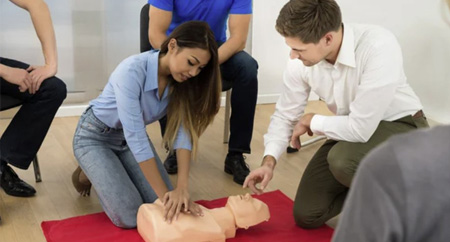Introduction
In our hectic globe, emergency situations can strike without warning. Whether it's a small injury, a medical emergency, or a life-threatening scenario, understanding how to supply first aid can make all the distinction. This is where a First Help course enters into play. Many people might question what they can obtain from such training, and this write-up aims to clarify that.
By joining in a First Help and mouth-to-mouth resuscitation course, you do not simply learn more about bandaging wounds or carrying out CPR; you furnish on your own Hobart First Aid Course with very useful abilities that can conserve lives. So, exactly what will you learn in an extensive program? Let's dive into the details.
First Help Basics: What You'll Learn in a Comprehensive Course
Understanding First Aid
What is Initial Aid?
First aid refers to the initial assistance given to somebody struggling with an injury or health problem until expert clinical aid shows up. It includes numerous methods and skills varying from basic wound care to lifesaving techniques like CPR (Cardiopulmonary Resuscitation).
Importance of First Aid Training
Why Must You Take an Emergency Treatment Course?
Taking a First Help course is important for numerous reasons:
- Confidence: Knowing exactly how to respond in emergency situations can instill confidence. Life-Saving Skills: The capacity to carry out mouth-to-mouth resuscitation or help with choking can save lives. Career Innovation: Lots of occupations need accreditation in very first aid. Community Obligation: Learning methods you can assist others effectively.
Overview of CPR
What is CPR?
CPR, or Cardiopulmonary Resuscitation, is an emergency situation treatment executed when a person's heartbeat or breathing has actually quit. It incorporates chest compressions with rescue breaths to keep blood circulation and oxygenation until expert help arrives.
The Framework of a Comprehensive Emergency Treatment Course
What Does a First Aid Course Include?
An all-around First Aid and CPR course normally covers the adhering to topics:
Introduction to First Aid Legal and Ethical Considerations Scene Safety Basic Life Assistance (BLS) CPR Techniques Choking Relief Wound Care Management Burn Treatment Managing Shock Recognizing Clinical Emergencies Using an Automated External Defibrillator (AED)Legal Aspects of First Aid
Are There Legal Implications Associated With Offering First Aid?
Yes, supplying first aid does lug lawful responsibilities known as "Do-gooder regulations." These laws shield individuals who help others in emergency situations, supplied their activities are reasonable and not reckless.

Scene Security: The Very First Step
How Do You Make certain Scene Safety?
Ensuring scene safety entails analyzing the atmosphere before approaching the sufferer:

- Look for possible threats (traffic, fire). Make sure it's secure for both you and the victim.
Basic Life Assistance (BLS)
What Duty Does BLS Play in Emergency Situations?

Basic Life Support consists of the basics of maintaining life features until additional medical help shows up. This section covers important abilities such as:
- Checking responsiveness Activating emergency services Performing top notch breast compressions
Advanced mouth-to-mouth resuscitation Techniques
What Are Advanced Techniques Covered in CPR Courses?
Advanced methods might consist of:
- Two-rescuer CPR Use of barrier tools for rescue breaths Special factors to consider for infants and youngsters
Choking Relief Techniques
How Do You Assist A Person That is Choking?
Choking alleviation entails 2 critical techniques:
The Heimlich maneuver for adults. Back blows and upper body thrusts for infants.Wound Care Management
How Do You Appropriately Take Care Of Wounds?
Effective wound administration entails:
- Cleaning the injury with saline or tidy water. Applying antibiotic ointment. Covering it with sterile dressings.
Burn Treatment
What Work Methods for Dealing With Burns?
Burn treatment differs by level:
Cool the shed under running water. Cover it with non-stick dressings. Seek clinical attention for severe cases.Managing Shock
How Is Shock Identified and Treated?
Recognizing shock includes looking for signs like light skin, rapid pulse, or complication:
Lay the person down. Elevate their legs unless there are injuries avoiding this. Keep them relax until help arrives.Recognizing Medical Emergencies
What Sorts of Medical Emergencies Should You Understand Of?
Common clinical emergencies include:
- Heart assaults Stroke Severe allergic reactions Understanding these conditions aids you act quickly.
Using an Automated External Defibrillator (AED)
How Do You Utilize an AED Correctly?
Using an AED entails transforming it on, attaching pads according to illustrations on the tool, and adhering to voice prompts carefully.
Importance of Constant Learning
Why Is Constant Learning Important in Emergency Treatment Training?
Continuous discovering ensures you remain updated on ideal techniques and new methods in emergency treatment care.
FAQs Regarding Emergency treatment Courses
What Is Consisted of in a Requirement First Aid Course?- A standard training course normally covers basic life assistance, injury monitoring, choking relief strategies, and lawful considerations.
- Most courses range from 6 hours to 16 hours depending upon the deepness of web content covered.
- Yes, upon effective completion of the majority of programs, individuals receive a first help certificate, which is usually valid for 2 years.
- Yes! Many companies use online courses that supply versatile discovering environments while still being effective.
- Absolutely! Hands-on technique is crucial for understanding abilities like breast compressions and utilizing AEDs effectively.
- Generally, there are no age restrictions; nonetheless, participants need to be psychologically competent to learn these life-saving abilities effectively.
Conclusion
Enrolling in a detailed emergency treatment course equips individuals with important knowledge that can save lives during emergency situations-- whether in your home, job, or out in public spaces! From understanding fundamental life support procedures such as mouth-to-mouth resuscitation to learning just how to handle injuries properly or identify indications of shock-- these training courses give very useful training that any individual can profit from!
As we navigate with our every day lives loaded with unpredictability-- what better method than preparing ourselves with knowledge gained from organized training sessions focused on conserving lives?
In verdict-- if you're considering using up any kind of first-aid training-- never ever think twice! Furnish yourself today with these effective tools since preparedness absolutely makes all the difference when every 2nd counts!